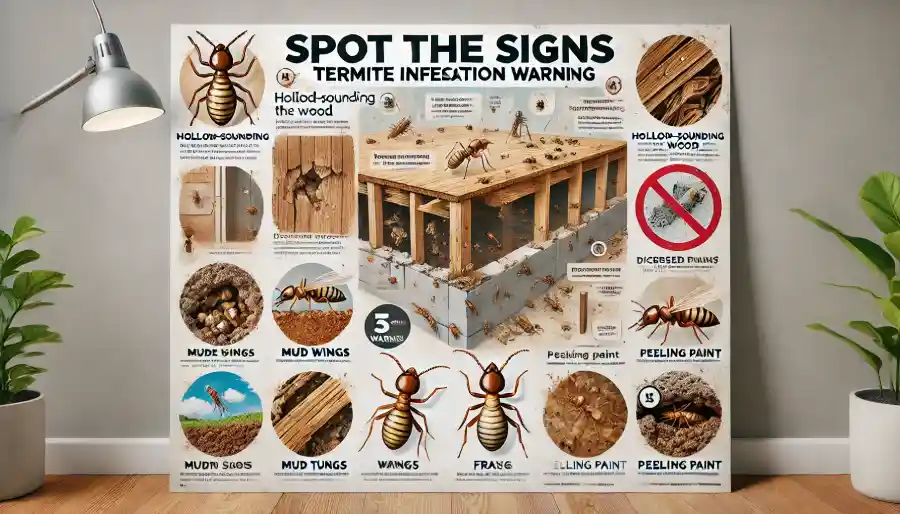Spot the Signs: Termite Infestation Warning
Identify termite infestations by looking for mud tubes, damaged wood, and discarded wings. Hollow-sounding wood, bubbling paint, and frass (termite droppings) are also indicators. Regularly inspect vulnerable areas, especially in basements and crawl spaces, to detect these signs early and prevent extensive damage to your home.
Introduction to Termite Infestations
Despite their seemingly innocuous appearance, termites may seriously ruin your property. Identifying the initial signs of a termite invasion can prevent unnecessary troubles and expenses. This article will cover critical indicators of termite activity, what to look for, and steps to take if you suspect these pests have invaded your home. If you’re a homeowner seeking Termite Control in Cincinnati Ohio, knowing these signs can be crucial for early intervention and minimizing damage.
Why Are Termites a Big Deal?
Regarding household pests, termites are often most feared by homeowners—and for good reason. Termites are infamous for their ability to demolish timber constructions silently. Since they attack from the inside out, unlike other pests, it is challenging to identify them until considerable harm has been done. In the United States alone, termites have cost billions of dollars in repairs and treatments. Without being seen, they may gnaw through flooring, wallpaper, and wood, gradually compromising the structural stability of your house. Knowing what to watch out for can help you act swiftly and mitigate these risks, ultimately saving you time, money, and a lot of stress.
Common Signs of Termite Infestation
A keen eye can help you spot the common signs of termite infestation before they escalate into major problems. Here are some key indicators:
- Mud Tubes: Termites construct small, tube-like structures for shelter as they travel between their colony and food sources. These tubes provide moisture and protection from predators and the environment. They are often visible on walls, foundations, and other surfaces. Look for these telltale signs around the exterior of your home, especially near the foundation and in crawl spaces.
- Discarded Wings: Reproductive termites, or swarmers, shed their wings once they’ve found a new nesting site. This usually happens near windowsills, doorways, or other entry points. Finding piles of discarded wings strongly indicates that a new termite colony is establishing itself nearby.
- Hollowed Wood: Termites weaken and hollow out wood by feeding on it from the inside out. Tapping on compromised wood often sounds hollow, and affected areas may feel soft or spongy. Damage of this kind may jeopardize the structural integrity of essential components of your house, such as support structures, joists, and beams.
- Frass: Termite droppings, or frass, look like tiny, wood-colored pellets. These droppings are often found near infested areas, such as windowsills, doorways, and baseboards. The presence of frass is a clear indicator of an active termite infestation.
Less Obvious Indicators
While some signs of a termite infestation are unmistakable, others can be more subtle. For example, you might notice blistered paint or areas in your home that look water-damaged without an apparent cause. Termites can create tunnels just beneath the surface, causing this damage. Similarly, you might see small, pinpoint holes in drywall or experience unexplained creaking and floor sagging. These less apparent indicators can often be overlooked, but they are just as important in identifying a potential termite problem early on. Keeping an eye out for these subtler signs can help ensure that you catch an infestation before it becomes a significant issue.
Preventive Measures
Prevention is far more effective regarding termites than dealing with an active infestation. Termites may be repelled largely by conducting routine inspections and keeping the area dry. Sealing cracks in your home’s foundation, ensuring proper ventilation in crawl spaces, and promptly fixing leaks can make your home less appealing to these pests. It might also be beneficial to keep wood piles and other possible food sources away from the foundation of your house. Learning about practical termite prevention tips can provide further insights into protecting your property. Regular maintenance and vigilance are your first defense against these destructive pests.
Taking Action If You Suspect Termites
It’s critical to take quick action if you discover any indications of a termite infestation. Time is of the essence when dealing with these pests, as they can quickly cause extensive damage. Consulting a professional pest control service is highly recommended. They may offer a comprehensive assessment and care plan specific to your circumstances. Professional intervention is crucial for effectively eliminating termites and preventing future infestations. For more insights, refer to this informative guide on termite control provided by the EPA, which offers comprehensive advice on various control measures and treatment strategies.
Conclusion
If termites are not controlled, they may cause silent devastation on your property. You can protect your home from substantial damage by staying vigilant and recognizing the early warnings. Regular inspections, preventive measures, and swift action are your best defenses against these stealthy pests. Termites pose a severe danger to the structural stability of your house, making them more than simply an annoyance. Recall the importance of early discovery when it comes to termites. Don’t wait until the damage is done—take action at the first sign of trouble to safeguard your home and investment. Your house may remain a secure refuge for you and your family if you take quick action and consult an expert.

